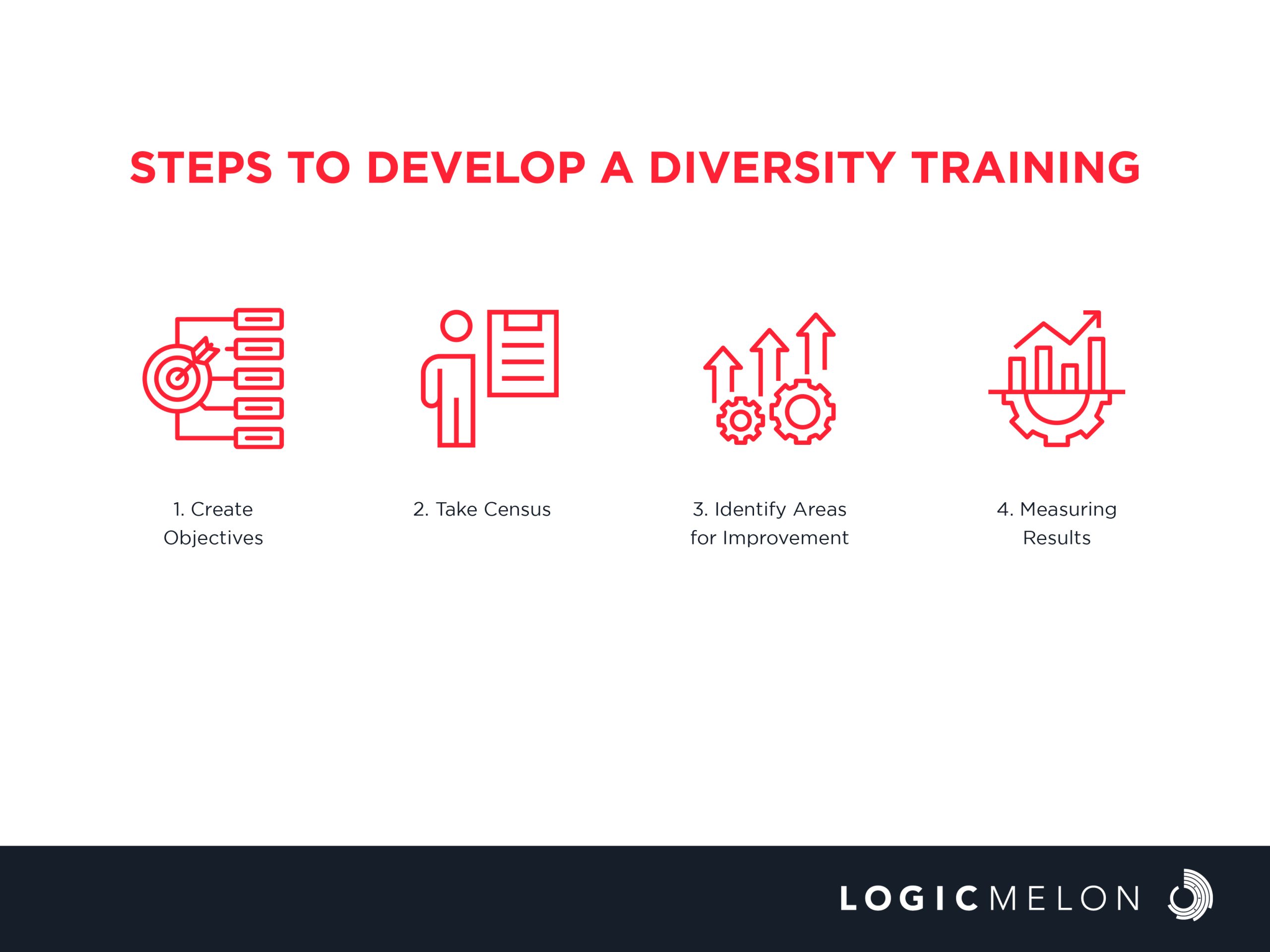The Importance of Diversity Training in the Workplace
We know that the omission of DEI practices affects inclusiveness, thereby hurting the employer’s brand value. Hence, it is necessary to include DEI practices through intensive diversity training programmes for the employees to increase employee engagement rates, which are essential to achieving a great company culture. In this article, you will understand how a diversified workplace can come together for a training programme to have an inclusive work environment.
Diversity training helps to build an understanding of the cultural competency and skills of employees and managers to understand their roles and responsibilities in meeting the organisation’s goals and objectives.
Steps to Develop Diversity Training

1. Create Objectives
An inclusive workplace is a work environment where people who feel valued work towards a business objective. First, it is vital to understand where the organisation stands in accordance with DEI practises. Once you have figured out the exact reasons and priorities, ensure the delivery of effective diversity training programmes to your employees.
2. Take Census
Draft a list of demographic characteristics that includes information about race, gender, disability, age, and nationality. Use these data to find areas of underrepresentation. The gaps in representation indicate potential diversity and inclusion challenges. Be realistic about what can be achieved with the training programmes and the team members available for achieving the specific objective.
3. Identify Areas for Improvement
Analyse the areas for improvement that need rectification to achieve the objectives. Determine the reasons behind underperformance and make sure to address the issues. Creating diversity training is a great way to address the biases and prejudices in the workplace. The employees must learn how to communicate and work as a team with their diverse team members. This training mainly focuses on areas such as creating new ways to communicate with a diverse workforce, encouraging skill training within the diverse team, and enhancing group dynamics in the workplace.
4. Measuring Results
The primary objective of diversity training is to teach employees to have the utmost respect for their coworkers, acknowledge cultural differences, and work towards business outcomes.
When employees feel excluded, the employee engagement rate starts to suffer, so it is important to ensure that the DEI practises are well-performed in the organisation to have increased employee engagement.
The Necessity of Diversity Training
Diversity is the result of people coming from different cultural backgrounds. A well-designed diversity training programme will help elevate morale, increase work satisfaction, and drive business success. Increased collaboration enhances interpersonal skills and empowers underrepresented groups. It is a valuable opportunity to drive awareness of the benefits of having a diverse workforce in the workplace.
Types of Diversity Training
1. Peer-to-peer Training
Peer-to-peer training is a training method that occurs without trainers or outside hires to provide insights. A peer-to-peer conversation encourages the team to improve its morale and get to know each other better.
2. Hybrid
The hybrid training method helps remote workers be aware of the training programmes. It does not promote cultural change; it promotes better awareness of diversity. Training programmes should be mandatory and it should be made clear that the organisation is committed to achieving its goals and objectives. With a hybrid work culture, it is important to ensure that the training programme reaches all the people it is intended for, that assessments can be conducted after the programme, and that corrective actions can be taken.
3. Gamification
Gamification is a strategic attempt to use stimulated activities such as games to engage employers to collaborate towards common objectives. The main idea of the game is to engage the users without awareness of their background or cultural heritage. Complete the task with a diverse group of people and provide encouragement until the end.
4. Awareness Training
Awareness training is a type of training that is about raising awareness about the importance of diversity in the workplace. The factors that are used to measure and train the employee are based on cross-cultural differences and communication with people from different backgrounds.
5. Skill-Based Training
This type of training aims to develop the skills of the employee in the workplace. The skills of an employee are necessary to do the job. Video lectures, presentations, and practical tasks are part of the training programmes.
Frequently Asked Questions
1. What is diversity training in the workplace?
Diversity training is a training programme conducted in the workplace to create an inclusive environment and help employees understand each other’s values so they can achieve goals and objectives effectively. Cultural differences are what make people unique in their ideas and beliefs.
2. Why are diversity training programmes required in organisations?
Diversity training is required in organisations to understand cultural differences and raise awareness of inclusive work culture so that organisations can achieve their goals and objectives effectively and efficiently. The goal of diversity training is to understand that even if there is a cultural difference among teams, one’s attitude adjustment to the situation is required to make the team extraordinary.
3. Why is an inclusive work environment necessary in organisations?
An inclusive work environment is necessary at organisations to improve the work culture so that every employee feels valued and plays their part in producing effective results. To get the best results from each employee.
Closing Thoughts
Every organisation has to make employees feel comfortable and ensure that underrepresented groups interact to achieve the goals and objectives of the organisation. An inclusive work environment makes every employee feel valued and comfortable enough to share their thoughts, ideas, and beliefs to improve business outcomes. Creating a diverse workplace is critical to an organisation’s success.
As an organisation continues to develop and grow over time, it is important to support the DEI training programmes to have an inclusive workplace. Developing diversity and inclusion training programmes starts with developing clear and detailed information about what the programmes should be.
LogicMelon
Award-winning recruitment software that will find, attract, hire and analyse the way you want to work. At LogicMelon, we have experienced software recruitment marketing specialists to help you build effective recruitment solutions supported by the best customer service you’ll find anywhere!
Email: sales@logicmelon.com or call LogicMelon (UK) +44 (0) 203 553 3667 (USA) +1 860 269 3089
Agile Recruitment: What Is It, What Are the Benefits, and How Do I Implement It?
The world has witnessed the positive impact an agile approach can have on accomplishing projects and collaborating.
10 Time Management Skills that Every Employee Needs
Time management skills are crucial for a business to achieve its goals. The workplace is dynamic, and employees must adapt to the change.
How to Create an ATS Friendly Resume
The ATS-friendly resume is a document passed through the ATS (Applicant Tracking System).To pass the ATS scan, the resume has to be formatted properly and include the right words. Read the blog to know more.


